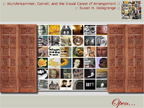When Revision Is Redesign: Key Questions for Digital Scholarship
Susan H. Delagrange
Code
Q: What are the affordances and constraints of learning and writing underlying code when designing the visual and conceptual interface of a multimedia project?
Finally, I want to argue for writing code, working under the hood of what-you-see-is-what-you-get software to more directly effect an interface that not only provides an optimal user experience, but also more precisely fits the design to the rhetorical argument.
Productive arts, or techné (Aristotle included medicine, architecture, and rhetoric as examples), occupy a middle ground between theory and practice, one that incorporates both abstract and applied knowledge.
Shortly after I submitted the first version of "Wunderkammer" in 2006, Adobe announced the release of Flash CS3 Professional, the first revision of Flash following their purchase of Macromedia, and also the first version to use Actionscript 3. AS3 is scripting language for Flash that has evolved from simple animated "actions" written in plain-English code into a fundamentally restructured program developers' tool for designing complex commercial interactive media. With a much steeper learning curve, custom AS3 design is less accessible for artists, scholars, and other non-experts.
Although AS2 was still supported in Flash CS3 Pro, I shifted to AS3 for the redesign of "Wunderkammer" for a couple of reasons. First, I wanted to publish on the technological bleeding edge so that the article would be readable by browsers for the longest possible time. More important for me, though, was the desire to push back against software that makes it ever more intimidating for non-experts to write scripting language, encouraging them instead to stay on the surface and choose from the burgeoning number of stock actions and choices available with a single click.
The idea of frictionless computing, in which the software provides transparent access to a process or activity, is problematic (Kaplan, 2001). Nancy Kaplan argues that reading and writing interactive media is an important new literacy practice, one that requires procedural as well as interpretive skills, and if we think that media literacy is a skill that our students should have, then we need to learn it ourselves too. We won't develop true literacy (which implies an ability to adapt to changing technological environments) if we adopt a fill-in-the-blanks mentality that informs the design of, for example, course management software like Blackboard and WebCT. Real learning requires significant cognitive engagement. From my perspective, it may not be necessary or sufficient to practice what I write about, but it helps; it helps a lot.

Actionscript 3 code for three buttons
Writing code is still considered by many to be technical work that can, even should, be passed off to others. But code is not merely a set of instructions. Design is a process of trial and error, manipulation and arrangement, invention and discovery. The foundation of digital design is software and its codes, and therefore writing scripting language in Flash is no less a practice of intellectual inquiry than is the production of the images and words and movement that are directed by software's invisible hand.
As I worked on the redesign, I repeatedly asked the same question about each aspect of the project: Is the default design choice the best rhetorical or aesthetic solution, or is it merely adequate? If Actionscript was necessary to adjust an action or tweak a text scroll to better enact my argument, I wrote it. (Code requires collaboration too, even among experts. Joe Bondra at Ohio State's Digital Union was my go-to person when language I wrote was having unexpected effects, and I spent several weeks emailing back and forth with Karl Stolley at Kairos about translating part of "Wunderkammer" into XML to make it more accessible and visible to search engines.)
Software is not just a technical artifact, it is also a social and cultural practice. The way software works shapes our use of it, and either enhances or limits how well we can express our ideas. To wish that the computer and its software "should play no detectable role in directing or shaping the activity" is to ignore the fact that it is already directing and shaping us. As Lev Manovich (2008) pointed out, "If we don’t address software itself, we are in danger of always dealing only with its effects rather than the causes: the output that appears on a computer screen rather than the programs and social cultures that produce these outputs" (p. 5). One way to make sure that we are paying attention is to delve into code.
